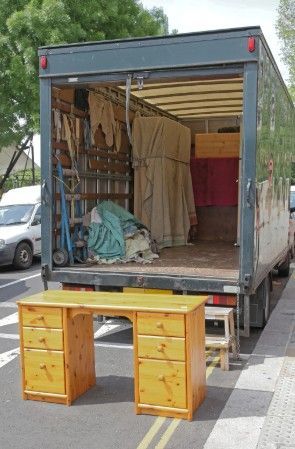How to Rehome Old Furniture Instead of Dumping It
Rehoming old furniture isn’t just a way to clear up space—it’s about allowing well-loved pieces to continue their journey. That worn-out recliner or the quirky vintage sideboard doesn’t have to meet a tragic end at the landfill. Instead, think of them as stories waiting for a new chapter. Listing your pieces on neighborhood platforms like Offer Up, Craigslist, or even Facebook Marketplace invites people who genuinely need or want your furniture into the fold.
Maybe it’ll find its way to a college student furnishing their first apartment or a young couple making a house a home. You’d be surprised how many lives a single piece of furniture can touch. It’s sustainable, socially conscious, and frankly, it just feels good to know something that once served you can go on serving someone else.
Transforming Trash into Treasure
Ever looked at an old bookshelf and imagined it as a rustic plant stand? That’s the magic of seeing potential where others see waste. Rehoming furniture doesn’t have to mean just giving it away—it can be a fun, fulfilling creative project. Think beyond the original purpose and let your imagination run wild. Give an antique chair a splash of bold color, or convert a dresser into a kitchen island.
These makeovers turn cast-offs into conversation pieces. Share your repurposed creations on social media or with local upcycling communities—you never know who might be inspired by your ingenuity. Plus, it keeps perfectly usable materials out of the dump. Turning trash into treasure isn’t just sustainable—it’s a celebration of creativity, history, and the joy of transformation. And hey, it's way more fun than lugging a sofa to the curb.
Sustainable Choices for a Greener Future
Choosing to rehome your furniture is a powerful eco-conscious decision. Instead of contributing to overstuffed landfills and increasing demand for resource-heavy new furniture, you’re actively reducing waste and carbon emissions. Every couch, table, or wardrobe that finds a second life is one less piece clogging up our planet. It also cuts down on the need for raw materials like wood and metal, preserving forests and reducing mining impacts. But the sustainability story doesn’t end there.
By encouraging a culture of reuse, you become part of a movement that values longevity over convenience. That’s something to feel good about. Imagine a world where every item is passed down, repurposed, or donated before being discarded. It’s not far-fetched—it’s a choice, and it starts with a simple question: who else could use this?
Embracing Minimalism Through Rehoming
Rehoming old furniture is more than a practical move—it’s a mindset shift. Minimalism isn’t about having less for the sake of it; it’s about having just what you need and love. When you let go of the coffee table that’s just collecting dust or the bookshelf that no longer fits your style, you’re not losing something—you’re gaining clarity. It creates space, both physically and mentally. That newfound openness in your home often leads to an unexpected peace of mind.
Rehoming instead of dumping also aligns with values of intentional living. You’re not just throwing things out—you’re placing them where they can thrive again. It’s conscious decluttering with a purpose, and in a world overflowing with stuff, that kind of mindfulness is refreshing. Living lighter doesn’t mean sacrificing style or comfort. It means making room for what truly matters.
Building Connections Through Furniture Rehoming
When you rehome furniture, you’re not just moving objects—you’re connecting lives. That old writing desk you no longer use might become the centerpiece in someone else’s home office. These exchanges build unexpected relationships, whether it’s a grateful thank-you from a stranger or a story shared over a driveway pickup. In a world that often feels disconnected, these small moments of community matter. Platforms like Buy Nothing groups, Next door, or local nonprofits make it easier than ever to rehome responsibly and compassionately.
It’s a feel-good cycle—what once served you now serves someone else. And in the process, you may even rediscover the kindness and generosity that still exists in the world. It turns an otherwise mundane furniture swap into a meaningful human exchange. Sometimes, the most lasting thing you give away isn’t furniture—it’s hope, connection, and a bit of neighborly love.
Rehoming as a Creative Outlet

Rehoming doesn’t always mean handing furniture off to someone else—it can be a deeply creative journey. Picture this: you’ve got a scratched-up coffee table that’s seen better days. With a little sandpaper, some stain, and a dash of vision, you turn it into a rustic, magazine-worthy centerpiece. Suddenly, you’ve not only saved it from the dump—you’ve made something uniquely yours. The process can be surprisingly meditative. It’s a mix of problem-solving, design, and hands-on satisfaction.
And let’s not forget how good it feels to create rather than consume. Share your reimagined pieces online or at local craft fairs—you might even inspire others to do the same. Rehoming through transformation allows your style and imagination to shine, and it gives old items a second act that’s more beautiful and intentional than the first.
Economic Advantages of Furniture Rehoming
Rehoming your furniture is not just about clearing space—it can also benefit your wallet. Selling gently used items through second-hand apps or garage sales can turn unused space-fillers into extra cash. Even donating can offer tax write-offs if you document the transaction correctly. On the flip side, acquiring second-hand furniture is a smart move, too. You can often snag high-quality, unique pieces at a fraction of what you’d pay retail.
It’s a win-win scenario—someone else gets a deal, and you get a few bucks or a tax break.
More importantly, it changes the way we view ownership. Furniture doesn’t need to be brand new to be valuable. Whether you’re on a tight budget or just appreciate a good deal, rehoming is a budget-friendly path that still lets you live in style.
Educational Opportunities in Rehoming
Rehoming old furniture can be a surprisingly rich educational experience, especially for kids. When children help sort, clean, or deliver unused items, they learn lessons about empathy, resourcefulness, and environmental responsibility. It becomes a hands-on activity that fosters gratitude and mindfulness. They begin to understand that what we no longer need might be vital to someone else. Plus, it introduces them to basic home repair and upcycling techniques.
Maybe that broken chair becomes a Saturday project, and in the process, a child learns to work with their hands, problem-solve, and think creatively. Rehoming offers more than just a cleaner garage—it creates teachable moments and instills lifelong values. Instead of shielding children from the realities of waste, it invites them into a solution-driven mindset. That’s a powerful gift disguised as a simple act of giving.
Enhancing Home Aesthetics Through Rehoming
Letting go of outdated or clunky furniture can dramatically change your home’s aesthetic. Imagine the new possibilities in your living room once that oversized entertainment center is gone. Suddenly, there’s space for light, movement, maybe even that minimalist look you’ve been eyeing on Pinterest. Rehoming isn’t just removal—it’s renewal. It allows your home to breathe again. Maybe you’ve outgrown a certain style or you’re craving something fresh.
By passing along what no longer fits, you make room for decor that better reflects your current taste. Sometimes, you don’t need to buy anything new. Just the act of removal reveals beauty you didn’t notice before. Your space transforms, not just in how it looks, but in how it feels. Rehoming is a design decision, a subtle makeover that begins with intention and ends in satisfaction.
Sustainable Choices for a Greener Future
Choosing to rehome your furniture is a powerful eco-conscious decision. Instead of contributing to overstuffed landfills and increasing demand for resource-heavy new furniture, you’re actively reducing waste and carbon emissions. Every couch, table, or wardrobe that finds a second life is one less piece clogging up our planet. It also cuts down on the need for raw materials like wood and metal, preserving forests and reducing mining impacts. But the sustainability story doesn’t end there.
By encouraging a culture of reuse, you become part of a movement that values longevity over convenience. That’s something to feel good about. Imagine a world where every item is passed down, repurposed, or donated before being discarded. It’s not far-fetched—it’s a choice, and it starts with a simple question: who else could use this?
Embracing Minimalism Through Rehoming
Rehoming old furniture is more than a practical move—it’s a mindset shift. Minimalism isn’t about having less for the sake of it; it’s about having just what you need and love. When you let go of the coffee table that’s just collecting dust or the bookshelf that no longer fits your style, you’re not losing something—you’re gaining clarity. It creates space, both physically and mentally. That newfound openness in your home often leads to an unexpected peace of mind.
Rehoming instead of dumping also aligns with values of intentional living. You’re not just throwing things out—you’re placing them where they can thrive again. It’s conscious decluttering with a purpose, and in a world overflowing with stuff, that kind of mindfulness is refreshing. Living lighter doesn’t mean sacrificing style or comfort. It means making room for what truly matters.
Conclusion
Rehoming old furniture is a multifaceted approach that benefits the environment, community, and personal well-being. It transforms the act of disposal into an opportunity for creativity, connection, and sustainability. By choosing to rehome, you contribute to a healthier planet, support others in need, and create space for new beginnings in your own life.
For assistance with junk removal or responsibly rehoming furniture in Littleton, contact Priority Junk Removal at 720-451-1359 or email priorityjunkremoval@gmail.com.











